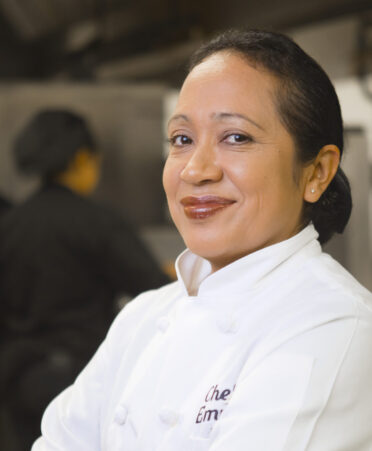(HARLINGEN, Texas) – The culinary industry was among the hardest-hit by the pandemic as restaurants closed their doors in early 2020 and diners stayed home. Many eateries shuttered for good, while others adapted quickly to new safety regulations and how they operated in order to stay in business.
Instead of despairing about the state of the industry that Texas State Technical College’s Culinary Arts graduates were about to enter, TSTC instructor Emma Creps used the tumult as a learning opportunity.
“We’re very excited about the new ways that we’ve transitioned into training our students and making sure that they’re fully prepared when they go into the industry,” she said. “I have quite a few industry partners that are constantly in touch with us letting us know, this is what we want. We’re pretty much right on track with what the industry’s looking for.”
Taking the popularity of ghost kitchens — eateries that do not have dining areas for patrons — in bigger cities as examples, Creps and her fellow instructors guided students to meet the challenges posed by COVID.
“The pandemic really allowed us to take off with it, teaching our students about the curbside, the carryout,” she said.
The experience is not unlike crafting a new recipe to delight palates, or thinking on one’s toes to make a dish with the fresh produce picked from the program’s garden on campus in Harlingen.
TSTC offers an Associate of Applied Science degree in Culinary Arts, as well as Culinary Assistant, Culinary Specialist and Culinarian certificates of completion.
In response to the pandemic, some TSTC culinary courses went virtual. Others remain in person, culminating in a hybrid format for the program.
At first, Creps doubted how successful virtual labs would be — especially with how hands-on instructors and students usually got in TSTC’s kitchens. Then, however, she witnessed the surprising fact that her pandemic cohort was right where they needed to be in their learning.
“We found that the virtual labs are very effective,” she said. “It has a lot to do with the instructor — how well they put it together and how they execute it. I was really happy with the performance of the culinary instructors and how much effort and work they put into it because we saw the results.”
In Texas, restaurant cooks can make an average of $25,440 a year, and chefs and head cooks can earn an average of $56,940 a year, according to the U.S. Bureau of Labor Statistics. Both careers have strong projected growth, onetonline.org forecasts, with 29% for restaurant cooks and 21% for chefs and head cooks through 2028 in Texas.
Creps’ students have found success beyond restaurants, she said. One recent graduate was hired as a culinary instructor at Hanna Early College High School in Brownsville. Others have found high-paying positions at H-E-B and even SpaceX.
Thriving in spite of the limitations that the pandemic placed on the food industry goes to show just how effectively Creps and her instructors can adapt TSTC students’ training to respond to real-world situations.
“We really like the challenges — coming up with new ideas and realizing this is the way of the future, how we’re going to do things from now on, because it hasn’t interfered with their training,” she said.
Learn more about TSTC at tstc.edu.
